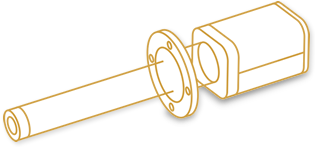Dryer Application
Wet Bulb Temperature Sensor for Dryer Optimization
The energy source for adiabatic drying is the sensible heat of a stream of air directed toward a bed or a stream of moist solids. Heat flows from the air to the solids, evaporating some of their moisture—in this respect, the governing force for drying is that of heat transfer. In this process the air is cooled, but its energy content (enthalpy) does not change, because the sensible heat loss equals the latent heat associated with its increased moisture content.
A wet-bulb temperature measurement is particularly important in drying operations. As moisture evaporates from the solid in an adiabatic dryer, its temperature approaches that of a wet-bulb thermometer in the same air, and remains at that temperature through the constant drying stage. As the wet bulb temperature and solids temperature start to diverge, a more accurate product moisture control can be attained by the relationship. The following equation can be used to predict the product moisture:
X=K*ln((Ti-Tw)/(To-Tw) where
X = product moisture
K = Dryer constant incorporating air flow, specific heat of air, latent heat of vaporization, dryer area and mass transfer coefficient
Ti = Dryer temperature
To = Dryer Outlet temperature
Tw = Exhaust gas wet bulb temperature
Downloadable Documentation
About H2O
For dryer wet bulb temperature applications, learn how the H2O dryer exhaust humidity sensor provides minimum maintenance and offers accurate readings on product moisture and energy usage. Contact Us Today.
Have A Question?

H20 Moisture Sensor Applications
Air heater in-leakageDry scrubber control
Environmental reporting
And much more...



